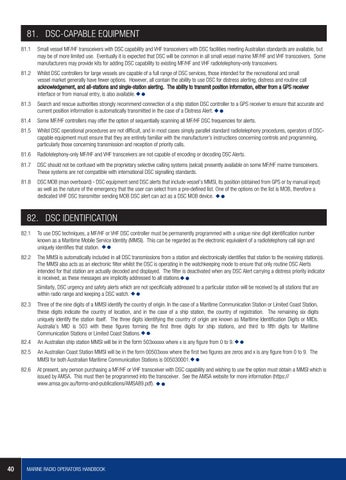81. DSC-Capable Equipment 81.1 Small vessel MF/HF transceivers with DSC capability and VHF transceivers with DSC facilities meeting Australian standards are available, but may be of more limited use. eventually it is expected that DSC will be common in all small vessel marine MF/HF and VHF transceivers. Some manufacturers may provide kits for adding DSC capability to existing MF/HF and VHF radiotelephony-only transceivers. 81.2 W whilst DSC controllers for large vessels are capable of a full range of DSC services, those intended for the recreational and small vessel market generally have fewer options. However, all contain the ability to use DSC for distress alerting, distress and routine call acknowledgement, and all-stations and single-station alerting. The ability to transmit position information, either from a GPS receiver interface or from manual entry, is also available. 81.3 Search and rescue authorities strongly recommend connection of a ship station DSC controller to a GPS receiver to ensure that accurate and current position information is automatically transmitted in the case of a Distress Alert. 81.4 Some MF/HF controllers may offer the option of sequentially scanning all MF/HF DSC frequencies for alerts. 81.5 Whilst DSC operational procedures are not difficult, and in most cases simply parallel standard radiotelephony procedures, operators of DSCcapable equipment must ensure that they are entirely familiar with the manufacturer’s instructions concerning controls and programming, particularly those concerning transmission and reception of priority calls. 81.6
Radiotelephony-only MF/HF and VHF transceivers are not capable of encoding or decoding DSC Alerts.
81.7 DSC should not be confused with the proprietary selective calling systems (selcal) presently available on some MF/HF marine transceivers. These systems are not compatible with international DSC signalling standards. 81.8
DSC MOB (man overboard) - DSC equipment send DSC alerts that include vessel’s MMSI, its position (obtained from GPS or by manual input) as well as the nature of the emergency that the user can select from a pre-defined list. One of the options on the list is MOB, therefore a dedicated VHF DSC transmitter sending MOB DSC alert can act as a DSC MOB device.
82. DSC Identification 82.1 To use DSC techniques, a MF/HF or VHF DSC controller must be permanently programmed with a unique nine digit identification number known as a Maritime Mobile Service Identity (MMSI). This can be regarded as the electronic equivalent of a radiotelephony call sign and uniquely identifies that station. 82.2 The MMSI is automatically included in all DSC transmissions from a station and electronically identifies that station to the receiving station(s). The MMSI also acts as an electronic filter whilst the DSC is operating in the watchkeeping mode to ensure that only routine DSC Alerts intended for that station are actually decoded and displayed. The filter is deactivated when any DSC Alert carrying a distress priority indicator is received, as these messages are implicitly addressed to all stations. Similarly, DSC urgency and safety alerts which are not specificially addressed to a particular station will be received by all stations that are within radio range and keeping a DSC watch.
40
82.3
Three of the nine digits of a MMSI identify the country of origin. In the case of a Maritime Communication Station or Limited Coast Station, these digits indicate the country of location, and in the case of a ship station, the country of registration. The remaining six digits uniquely identify the station itself. The three digits identifying the country of origin are known as Maritime Identification Digits or MIDs. Australia’s MID is 503 with these figures forming the first three digits for ship stations, and third to fifth digits for Maritime Communication Stations or Limited Coast Stations.
82.4
An Australian ship station MMSI will be in the form 503xxxxxx where x is any figure from 0 to 9.
82.5
An Australian Coast Station MMSI will be in the form 00503xxxx where the first two figures are zeros and x is any figure from 0 to 9. The MMSI for both Australian Maritime Communication Stations is 005030001.
82.6
At present, any person purchasing a MF/HF or VHF transceiver with DSC capability and wishing to use the option must obtain a MMSI which is issued by AMSA. This must then be programmed into the transceiver. See the AMSA website for more information (https:// www.amsa.gov.au/forms-and-publications/AMSA89.pdf).
MARINE RADIO OPERATORS HANDBOOK
